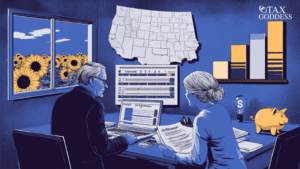Tax may be inevitable, but so is high inflation, as it seems. A lot of things are changing due to inflation. Everything is either getting smaller or more expensive. If people have to swap fresh food for frozen food and their $100 bill doesn’t have the same buying power as before, then inflation is a cause for alarm! While this high inflation period may affect your savings, investments, and the price of basic things, it may also help you reduce your tax bill next year.
As inflation rates change year to year, so do tax codes, which means significant changes in standard deductions and tax deductions in the coming year. In addition, because inflation affects all parts of the American economy, the federal government annually adjusts several elements of its intricate tax code to reflect high inflation and prevent tax rates from increasing.
These annual modifications mean you can save more tax money and reduce your tax bill. But how do you make the most of these tax breaks to scale through inflation?
Let’s Talk About Inflation!
Inflation occurs due to a rise in the demand for goods and services. As the total currency in circulation in an economy increases, there’s a chance of more customer demand. The more people buy goods, the higher the prices of goods.
As high inflation can be a threat, so can low inflation. The inflation crisis in the late 1970s and the 2000s are examples of risky low inflation rates. In the late 1970s and 1980s, the government had to fight double inflation rates by deploying monetary tightening measures to battle potential inflation.
In addition, in the wake of the 2008 inflation crisis, the US central bank expressed worries that inflation could go below zero, which would resort to deflation. The dreaded inflation eventually occurred in housing, and in the thick of it, the Federal Reserve had to target 2% annual growth inflation to revive the economy.
Since inflation has been modest in the last 10 years, only little tweaks have been applied to tax codes. However, with a record-high inflation spike this year due to factors converging during and after the COVID-19 Pandemic, there’s an urgent need for more adjustments in numerous tax provisions for this year and the following year to reduce the effect of the high inflation on taxpayers.
As a result, the middle federal tax rate of 24% applies to ordinary income exceeding $89,075 for single taxpayers and over $178,150 for married couples who file jointly. In 2023, the income threshold for the same tax bracket is projected to rise to about $95,375 for single taxpayers and $190,750 for married couples filing jointly.
Reduce Your Tax Bill With Inflation Relief
The most significant adjustment you’ll see in tax codes next year comes through the Inflation Reduction Act. The Inflation Reduction Act (IRA) was signed into law on August 16, 2022, and offers rebates and tax credits. The Inflation reduction Act will reduce costs for taxpayers and small businesses by maintaining a lower health care cost, bolstering supply chain resiliency, and supporting energy-saving investments. A great way to reduce your tax bill!
Significantly, the IRA extends the Affordable Care Act funding, previously due to expire by the end of 2022, through 2025 instead. It also raises the American Rescue Plan Act temporary exception that provides Premium Tax Credit for taxpayers with incomes above 400% of the Federal Poverty Income Level.
The IRA can also reduce your tax bill because it offers energy-efficient home improvement credits. From 2023, households will be able to claim thousands of dollars in rebates and tax breaks when they take steps to reduce their carbon footprints. Taxpayers who buy new electric vehicles can also get a tax credit worth about 7,500. If you are buying used cars, you could qualify for up to $4,000
Standard Deductions
If you don’t claim itemized deductions, standard deductions could help you reduce your tax bills as they are adjusted to account for inflation. The IRS released the standard deduction for 2023 on October 12, showing an increase in the standard deduction. The standard deduction for the 2023 tax year is $13,850 if you’re single, an increase of $900 from 2022. The 2023 standard deduction for married couples filing jointly will also increase by $1800, to sum up to $27,700
401K Max contributions
The threshold on how much you can contribute to your 401K is also adjusted with inflation in mind. This means you can contribute more to your 401K each year, especially when inflation is high, reducing your taxable income.
The 401K contribution limit for 2022 is 20,500, and if you are at least 50 years old, you could contribute an additional $6,500 as “Catch up” contributions for a total of $27,000 in 2022.
Health Savings Account
If you have a high-deductible health plan or a Health Savings Account, you can reduce your tax bill and enjoy a tax-free way to pay for qualified health expenses and increase your retirement savings. You can also enjoy an annually adjusted tax-deductible amount that you can contribute to your HSA. the contribution limit for 2022 is $3,650 for individuals and $7,300 for families. In addition, if you are 55 years old and above, you can also take advantage of the catch-up contribution of up $1,000.
Owing to inflation, the HSA contribution limit for 2023 will be adjusted upward by $200 for single taxpayers and $450 for families. In addition, taxpayers who are 55 and older can also take advantage of the catch-up contribution of $1000. This means the 2023 HSA contribution will be up to $3,850 for single taxpayers and $7,750 for family coverage.
Flexible Spending Accounts
The annual contribution limits for Health FSA are also adjusted for inflation. These adjustments can help stretch the value of the money you use in paying for qualified out-of-pocket health expenses. The FSA contribution limit for 2022 has increased to $2,850. The limit for 2023 is up by 7%, totaling $3,050.
Child Tax Credit, Adoption Credit, and Earned Income Tax Credit
The Child Tax Credit: the $2,000 Child Tax Credit may not be adjusted for inflation, but the refundable portion of the credit is. For 2022, the IRS has increased the refundable amount to $1500 and $1,600 for 2023.
Adoption Credit: if you decide to adopt a child, the IRS has slightly increased the maximum credit for adoption expenses for 2022 from $14,440 to $14,850. The maximum credit for adoption expenses for 2023 has also increased to $15,950, an increase of $1,060 from 2022.
Earned Income Tax Credit: the EITC is designed to help taxpayers within the low-to-moderate-income bracket reduce their tax liability. While the maximum credit amount is adjusted annually to accommodate inflation, there are also different EITC amounts for different categories of eligible taxpayers.
Take Home
While there’s not much you can do about the spiking inflation rate, you should take advantage of every tax credit, tax deduction, income limit, and standard deduction you qualify for to reduce your tax bill. You should also consider working with tax strategists like Tax Goddess to create an effective tax reduction strategy for our next tax bill.









